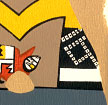History
Culture
Design &
Technique
How
To
Artists
Convocation
Glossary

Home
|
Pre-contact Dyes
Very little research has been done on prehistoric dyestuffs.
Bast, or plant fibers, naturally appear in a range of brown to
tan tones, and sometimes show a yellowish or greenish tint. Cotton
also shows some variety in color, mostly in the white to tan
range.
|
Pre-contact
Sewing
Brocade
or Embroidery?
Other Pre-contact Evidence
-Wall Paintings
-Designs
-Dyes
-Weaving
Techniques
|
|
| |
| |
Various plants produce
colors that will dye cotton and bast fibers, most notably indigo,
which produces a strong and lasting blue color. We do not know
when Southwestern people first began using indigo. It may have
been available in the southern areas as early as 1100 A.D. Certainly
by the time the Spanish invaded in the sixteenth century, the
Pueblos were using indigo to decorate their textiles. They also
seem to have used some mineral ores, such as iron. |
|

Painted yucca fiber carrying band, notheastern Arizona |
| |
Evidence exists of a variety of
dyeing processes. In some cases, Southwestern people seem to
have dyed the yarns by soaking them with some plant or mineral.
In other instances, they instead coated the yarns with pulverized
minerals in a process referred to as “dry dyeing.” Yet
other textiles were painted; that is, the maker suspended pulverized
minerals in some sort of medium--water, animal fat, or plant
sap--and applied the mixture to the fabric. |
|
| |
Some
textiles also show signs of having been “tie-dyed,” a
technique in which design areas were bound, or tied, in order
to prevent
the dye
from penetrating the bound area while the textile soaked in
the dye bath. This technique produces a pattern by contrasting
the
dyed areas with the original, undyed cloth.
|
|

|
| |
Representations of tie-dye from
the kiva at Awatovi |
| |
Unfortunately, analyzing
ancient textiles to determine the process and materials used
to color a fiber often destroy the fiber. Since we have so few
scraps of ancient textiles, such destructive but informative
analyses are rare. The removal of preservatives such as paraffin
can also damage or destroy a textile fragment. Further study
awaits the invention of less destructive techniques. |
|
|
|
|
|
|
|
|
|
|

School for Advanced Research